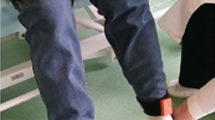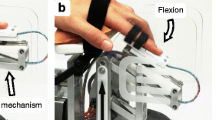Abstract
Testing of sensory-motor performance and motor rehabilitation training in post-stroke patients are often executed in lying position. At the same time, influence of the body position on proprioceptive perception is poorly studied. In this study, we have investigated proprioceptive perception of single-joint arm movements in 10 healthy subjects and 17 post-stroke patients with unilateral arm paresis in the sitting and lying positions using the method we developed. Movements of flexion–extension in shoulder, elbow and wrist joints and abduction–adduction in shoulder and wrist joints were tested. The subjects were made to perform a series of the passive single-joint movements with the eyes closed and had to copy these movements simultaneously by active movements of another arm. We recorded the angles at the tested joint and the homonymous joint of the other arm, and the status of proprioceptive sensitivity was evaluated basing on the degree of similarity of these “passive” and “active” movements. Qualitative and quantitative indicators were used to assess the similarity. It was found that healthy subjects reproduce the passive movements without rough qualitative errors in both the sitting and lying positions. The movement reproduction was less accurate in the lying position by values of some quantitative indicators, however only 3% of trails did not match the conventional criterion for proprioceptive sensitivity intactness. On the contrary, the movement reproduction in almost half of tests in the group of post-stroke patients was performed with qualitative and quantitative errors and did not match the requirements of the conventional criterion. A deficit of proprioception was observed in 1 to 5 different test-movements in 88% of patients in the sitting position and 71% of patients in the lying position. Most frequent and rough errors in the movement reproduction were observed in distal segments of the paretic arm. It was found that the body position could have different effects on the proprioceptive perception of the same test-movement in patients: the proprioceptive perception was evaluated as intact in the sitting position and as distorted in the lying position in 14% of all test trials and vice versa it was evaluated as distorted in sitting position and as intact in lying positions in 17% of trials. Such individual differences must be considered when choosing conditions for motor rehabilitation procedures in patients with paresis of the arm.



Similar content being viewed by others

REFERENCES
Damasio A.R., The Feeling of what Happens: Body and Emotion in the Making of Consciousness, New York: Harcourt Brace, 1999.
Kozlovskaya, I.B., Afferentnyi kontrol’ proizvol’nykh dvizhenii (Afferent Control of Voluntary Movements), Moscow: Nauka, 1976.
Dukelow, S.P., Herter, T.M., Moore, K.D., et al., Quantitative assessment of limb position sense following stroke, Neurorehabil. Neural Repair., 2010, vol. 24, no. 2, p. 178.
Schabrun, S.M. and Hillier, S., Evidence for the retraining of sensation after stroke: a systematic review, Clin. Rehabil., 2009, vol. 23, p. 27.
Sullivan, J.E. and Hedman, L.D., Sensory dysfunction following stroke: incidence, significance, examination, and intervention, Top Stroke Rehabil., 2008, vol. 15, p. 200.
Coupar, F., Pollock, A., Rowe, P., et al., Predictors of upper limb recovery after stroke: a systematic review and meta-analysis, Clin. Rehabil., 2012, vol. 26, p. 291.
Pavlova, O.G., Roschin, V.Y., Sidorova, M.V., et al., Method for qualitative and quantitative assessment of proprioceptive perception of single-joint arm movements, Hum. Physiol., 2018, vol. 44, no. 4, p. 445.
Stakhovskaya, L.V. and Kotov, S.V., Insul’t: Rukovodstvo dlya vrachei (Stroke: Handbook for Physicians), Moscow: Med. Inf. Agentstvo, 2014.
Meyer, S., Karttunen, A.H., Thijs, V., et al., How do somatosensory deficits in the arm and hand relate to upper limb impairment, activity, and participation problems after stroke? A systematic review, Phys. Ther., 2014, vol. 94, no. 9, p. 1220.
Naito, E., Morita, T., and Amemiya, K., Body representations in the human brain revealed by kinesthetic illusions and their essential contributions to motor control and corporeal awareness, Neurosci. Res., 2016, vol. 104, p. 16.
Jackson, J.H., Evolution and dissolution of the nervous system. Lecture I, in Selected Writings of John Hughlings Jackson, Taylor, J., Ed., London: Staples Press, 1958, vol. 22, p. 45.
Winward, Ch.E., Halligan, P.W., and Wade, D.T., Current practice and clinical relevance of somatosensory assessment after stroke, Clin. Rehabil., 1999, vol. 13, no. 1, p. 48.
Proske, U. and Gandevia, S.C., The kinaesthetic senses, J. Physiol., 2009, vol. 587, no. 17, p. 4139.
Funding
This work was partially supported by the Russian Foundation for Basic Research grants nos. 16-29-08181 and 19-015-00264.
Author information
Authors and Affiliations
Corresponding author
Ethics declarations
Ethical standards. All studies were conducted in accordance with the principles of biomedical ethics formulated in the 1964 Helsinki Declaration and its subsequent updates and approved by the local ethical committees of the Institute of Higher Nervous Activity and Neurophysiology of the Russian Academy of Sciences (Moscow) and Medical Rehabilitation Center of the Ministry of Health of the Russian Federation (Moscow).
Informed consent. Each research participant presented a voluntary written informed consent, signed by him (her) after explaining to him (her) the potential risks and benefits, as well as the nature of the upcoming research.
Conflict of interest. The authors declare the absence of overt and potential conflicts of interest related to the publication of this article.
Rights and permissions
About this article
Cite this article
Roschin, V.Y., Pavlova, O.G., Selionov, V.A. et al. Comparison of Objective Indicators of Proprioception of Single–joint Arm Movements in Healthy Subjects and Post–Stroke Patients in Sitting and Lying Positions. Hum Physiol 45, 397–404 (2019). https://doi.org/10.1134/S0362119719040133
Received:
Revised:
Accepted:
Published:
Issue Date:
DOI: https://doi.org/10.1134/S0362119719040133



